Shotgun Life in Gardone Val Trompia: Part 7, Giancarlo e Stefano Pedretti Incisori
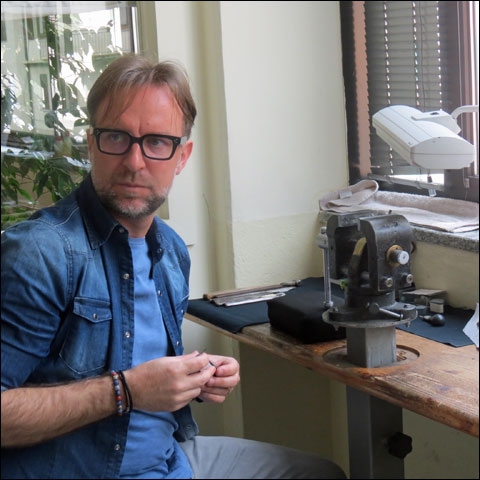
In late March and early April of 2017, Shotgun Life visited the legendary Gardone Val Trompia in the province of Brescia, which is the heart of Italy’s shotgun manufacturing. We spent time with shotgun makers Perazzi, Beretta, FAIR and F. illi Poli as well as master engravers Stephano Pedretti, Creative Art, Francesca Fracassi and Cesare Giovanelli. Here is Part 6 of our eight-part series called Shotgun Life in Gardone Val Trompia.
In late March and early April of 2017, Shotgun Life visited the legendary Gardone Val Trompia in the province of Brescia, which is the heart of Italy’s shotgun manufacturing. We spent time with shotgun makers Perazzi, Beretta, FAIR and F. illi Poli as well as master engravers Stephano Pedretti, Creative Art, Francesca Fracassi and Cesare Giovanelli. Here is Part 6 of our eight-part series called Shotgun Life in Gardone Val Trompia.
One timeline that tracks Medieval to Modern Europe runs through the steep valley we know as Val Trompia in Northern Italy. For our purposes, let’s say the clock started ticking when Beretta used the iron ore and river water of Val Trompia to make gun barrels for the Venetian fleet in preparation for the Battle of Lepanto in 1571.
The gods of time would smile on Val Trompia – their chosen son the pre-Roman industrial city of Brescia. The passing of centuries produced advances in gunmaking fueled by the indigenous iron ore, Mella River water, blast furnaces, gifted genius, artistic obsession, sweat, love, mysticism, pain and revenge. Generations of aproned craftsmen in rustic, hillside workshops collaborated on magnificent shotguns from the houses of Bosis, Beretta, Abbiatico & Salvinelli, Bertuzzi and marques that have earned international distinction or were lost to history.
Innovation is virulent among the gun-making clans of Brescia. It seems that nearly everyone is related by blood. Ideas are shared, hoarded or stolen. Maybe the patent books are helpful in assigning specific inventions, but otherwise sourcing the origins of those so-called tipping points of ingenuity will send you down a rabbit hole.
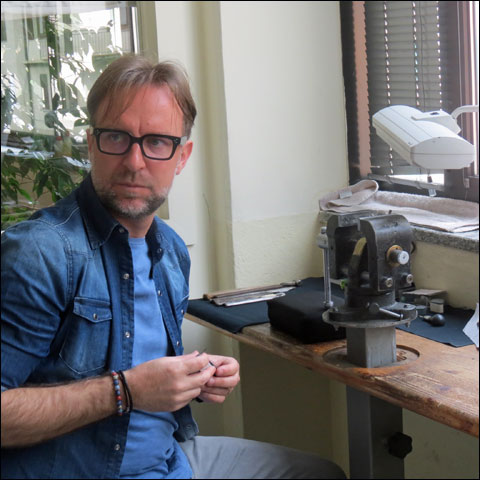
Stefano Pedretti
Master Engraver Stefano Pedretti, though, can point to the 2002 Safari Club Convention in Reno, Nevada when he learned from an American company about using the microscope to gain a higher level of detail in his artistry. Returning to Brescia, he would become Italy’s first engraver to see his images amplified to the dramatic intensity beyond the traditional magnifying loupe.
With the microscope, Mr. Pedretti and his father, the great Giancarlo Pedretti, could render near-photo realism through the bulino engraving style they committed to perfect.
“Yes, I was the first Italian engraver to use a microscope,” he told us from the bright, modern studio awash in natural light from the wall of windows that faced Mediterranean-style apartments and hillsides of grass and trees.
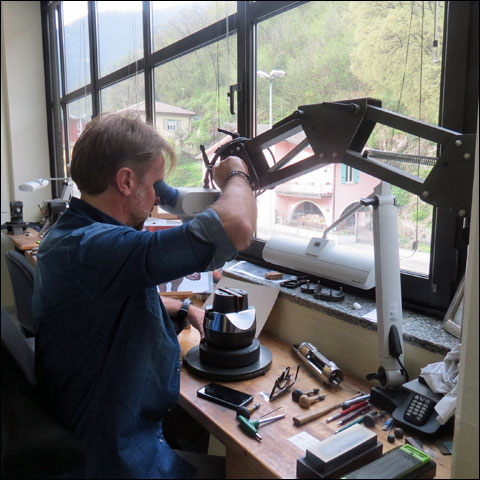
Stefano Pedretti using a microscope at his engraving bench.
The Pedrettis have earned the legacy of a coffee-table book, “Giancarlo & Stefano Pedretti Master Engravers” by Stephen Lamboy and Elena Micheli Lamboy, which chronicles their history, influences and artistry.
Stefano’s father, Giancarlo, was born into a family of Gardone gunmakers. He spent summers on his grandparent’s farm where he gained an appreciation for nature and upland hunting. Giancarlo’s father and brother worked for Beretta and helped launch the SO (Special Order) series of shotguns in Cappa Due (K2) favored by corporate giants, royalty and celebrities. At age 13, his father got him an apprenticeship with the great engraver Stefano Tonocelli.
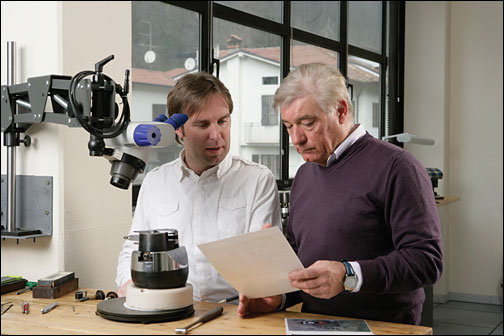
Stefano (left) with his father Giancarlo in Giancarlo e Stefano Pedretti Incisori.
The Lamboys write that three years later Giancarlo was hired by Beretta as an apprentice engraver – mentored by some of the best in Italy. He subsequently broke away to work independently from his home studio, where he focused exclusively on the beautiful shotguns by Abbiatico & Salvinelli. Following the death of Mario Abbiatico, Giancarlo was discovered by Purdey where he began a long-term creative collaboration with the English best gunmaker.
While studying drawing at the Caravaggio School of Art in Brescia, Stefano devoted time learning engraving from his father. He graduated cum laude from the art school in 1991. That year proved pivotal for the Pedrettis, as documented by the Lamboys.
Stefano’s sister, over dinner one night, confessed that she didn’t want to follow her father into the engraving business. Giancarlo was disappointed. Stefano then offered to work for his father before serving a stint in the military. If Stefano could not meet their mutual expectations, his father would send him to graduate school for drawing.
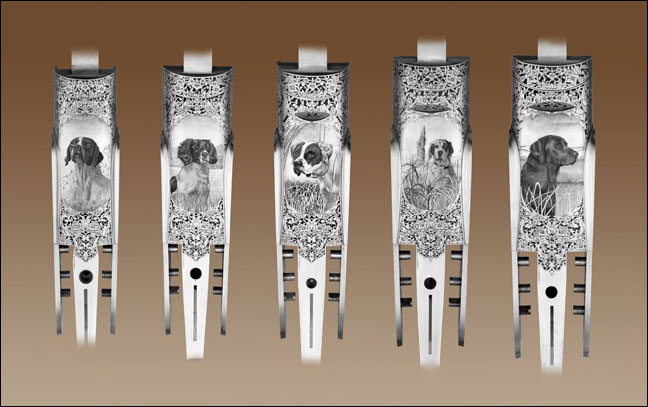
Five Boss shotguns for a collector engraved by Giancarlo e Stefano Pedretti Incisori.
We already know the path that Stefano would ultimately pursue. In getting there, though, the 1990s was a decade of discovery for the father-and-son duo as they concentrated on the photo-realism technique of engraving called bulino, which dates back to the Battle of Lepanto. Stefano would spend weeks at Purdey’s engraving studio and collaborate with American gunmaker visionary Anthony Galazan, who was turning his attention at Connecticut Shotgun Manufacturing Company to expensive sidelocks meant to rival the British best. Mr. Galazan tapped the Pedrettis to infuse his new upland shotguns with the superlative distinction of bulino ornamentation.
Pushing the mushroom-cap handle of a pointy bulin chisel, engravers cut miniscule lines and dots into the steel. The technique yields a fine-art half-tone evocative of Renaissance engravings. When creating bulino depictions involving dogs and birds, specifics of the coats, feathers, anatomical proportions and the natural world in foreground and background render a highly particularized freeze-frame instant: an exuberant Lab stretched full stride pursuing a spread-winged pheasant through sunflowers.
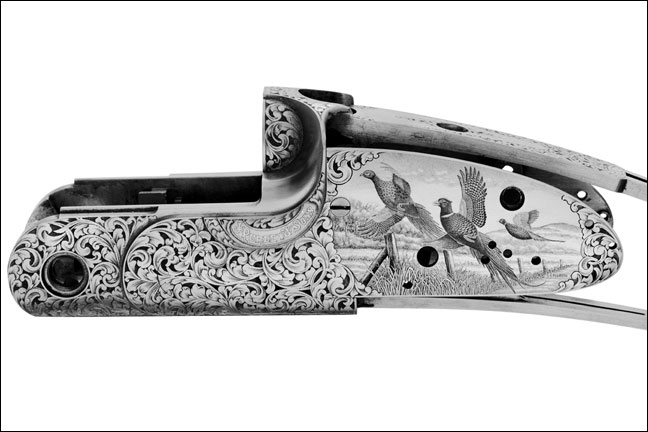
A Purdey shotgun engraved by the Pedrettis.
Giancarlo and Stefano originated burnishing and treating 24-karat and multi-colored gold into their bulino compositions –a new twist on the precious-metal highlights by avant-garde fantasy engravers such as Creative Art Studio and Manrico Torcoli. The Lamboys say that Pedretti’s initial multi-colored gold gun for Mr. Galazan required six months to complete.
Despite the 1990s economic recession, the Pedretti’s mastery of bulino game scenes attracted commissions from well-heeled collectors and superb gunmakers willing and able to pay for their masterpieces.
The ascendency of Stefano Pedretti continues after his father died unexpectedly on September 28, 2016, five months before our visit. “Since 1992 we’ve never been out of work,” he said. “I have a full pipeline. And it’s not just hunting guns anymore,” referring to an influx of sporters from the likes of Krieghoff and Blaser.
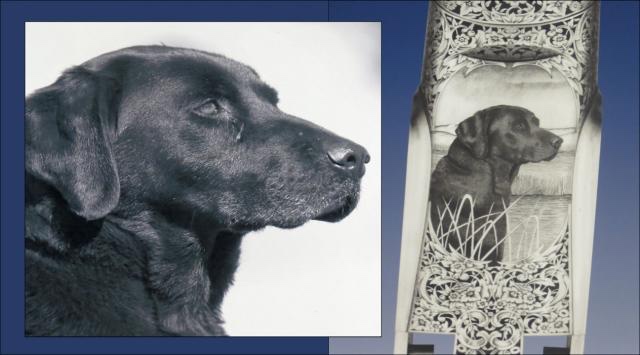
Stefano Pedretti turns the drawing of the black Lab into an engraving on one of five Boss shotguns.
Many collectors’ commissions are for bird dogs, some of the business derived from quail hunting with American clients in places like Georgia and Texas, where he can actually research the terrain as part of the overall scene. Once at the bench, though, “the hardest thing about engraving dogs is capturing their essence and facial expressions,” he explained. “Engraving black dogs is extremely difficult. It can take me one-thousand hours to finish a dog.”
And this is where the microscope comes in. He described how the traditional engraver lens has a 10X to 12X magnification. “The microscope lets me sit upright (less fatigue) and go up to 20X magnification and even a 10X microscope is better than a 10X loupe.” He continued that while a loupe will generally only show one centimeter of the engraving area, a microscope shows the entire composition surface. “It took me five months to get accustomed to the microscope.”
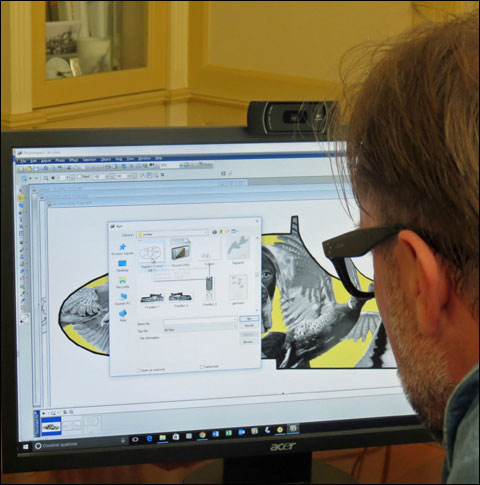
Stefano Pedretti’s software compiles several game animal images into one illustration (shown below) that would become an engraving. The yellow background signifies 24-karat gold on the shotgun.
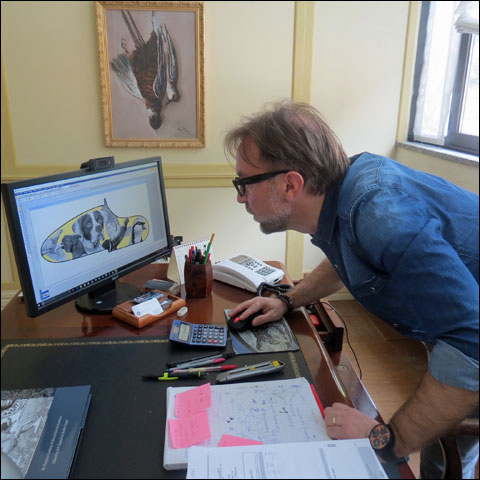
In his quest for perfection, Mr. Pedrettti added that “We use technology to increase the quality of our engraving.”
In fact, he’s constantly updating computer-based libraries of images that he can cut-and-paste into a compiled “sketch” for his next shotgun.
“All the images are scanned and traced on paper,” he explained. “My father was very supportive of using technology to improve our craft.”
For Stefano the studio will always live on as “Giancarlo e Stefano Pedretti Incisori.”
Irwin Greenstein is the publisher of Shotgun Life. You can reach him at contact@shotgunlife.com.
Useful resources:
The web site for Giancarlo e Stefano Pedretti Incisori
Shotgun Life in Gardone Val Trompia: Part 1, Fabbrica Armi Isidoro Rizzini (F.A.I.R.)
Shotgun Life in Gardone Val Trompia: Part 2, Perazzi
Shotgun Life in Gardone Val Trompia: Part 3, Fratelli Poli Armi
Shotgun Life in Gardone Val Trompia: Part 4, Beretta
Shotgun Life in Gardone Val Trompia: Part 5, Firmo & Francesca Fracassi
Shotgun Life in Gardone Val Trompia: Part 6 Creative Art Engravers

Irwin Greenstein is Publisher of Shotgun Life. Please send your comments to letters@shotgunlife.com.


Comments